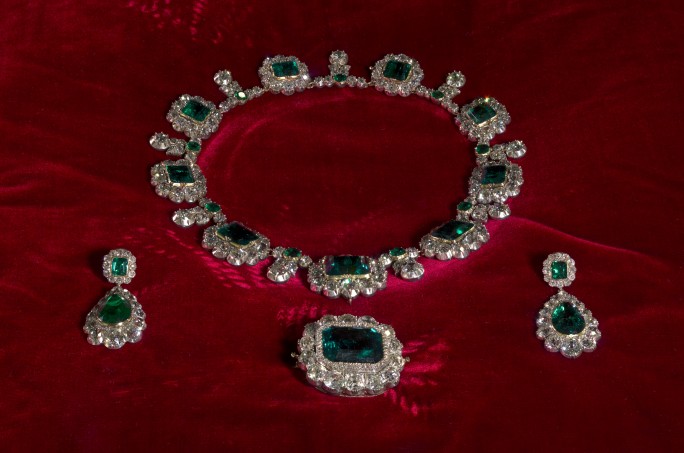
The Victorian Period (1837-1901)
Queen Victoria reigned for a long time as you can see from the dates above! In fact, during her reign there were nine, yes nine Prime Ministers!
It was an era very much based on class with clear divisions in wealth distribution between the classes. During this time, a growing number of people were able to vote, which built individuals’ confidence. There was also a growing economy and Britain was the most powerful Empire in the world, until the end of the period.
There were huge advancements in technology with the Industrial Revolution. Therefore the ability to produce jewellery at a larger scale and for a greater proportion of the population was made possible.
Jewellery historians usually break this era down into three periods: Early (or Romantic), Mid (or Grand), and Late Victorian (or Aesthetic). As such, we’ve organised the information in this article to correspond to those periods. You will see that each have individual styles due to shifting moods, technological advancements and discoveries.
Early or Romantic Victorian Jewellery (1837-1860)
The jewellery of the Early Victorian Era reflected the love and hope the young queen had for her husband, Albert (they married in 1840). This era was often characterised by a ‘return to nature’ and alongside the Bible nearly all households had a book for deciphering the language of flowers. It is said that Queen Victoria fuelled a nationwide and potentially even worldwide love affair with jewellery and its symbolism. Her love of diamonds and turquoise, to name just a couple of her favourite gems, really accelerated their popularity.
The 1840s saw the start of large-scale jewellery manufacturing. However, jewellers were still making many pieces by hand and these pieces are especially sought after in today’s market.
Motifs and symbolism in Early or Romantic Victorian Jewellery
Popular ring motifs included snakes as symbols of eternal love. Prior to their marriage Albert gave Victoria a snake ring with an emerald embedded into it as a symbol of their love. Other fashionable motifs at the time included: angels, love knots, hearts, crosses, clovers and of course flowers. In addition, designs with Greek, Roman or with Celtic influence were popular, as Prince Albert bought Queen Victoria Balmoral Castle in 1852, having leased it in 1848.

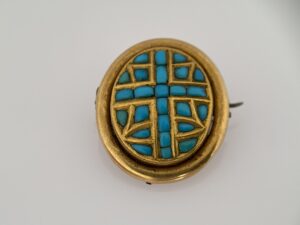
Gem Cutting Styles and Settings in Early or Romantic Victorian Jewellery
Gems were largely cut as either:
- rose cut – round shape with a faceted domed top and flat bottom
- old mine cuts – a forerunner to the old European cut and therefore modern brilliant cut
- cabochons – smooth domed top flat bottom
- step cuts – usually for coloured stones forming a series of straight facets that decrease in length as they recede from the girdle and so give the appearance of steps
Collet settings as seen in Georgian jewellery continued during this time, but now with open backs, and claw like prong settings were also used.
Brooches were now commonly secured using the simple ‘C’ clasp, where the pins extended past the body of the brooch (can be seen in image above, back view available on product page).
Popular Gemstones in Early or Romantic Victorian Jewellery
Diamonds, turquoise, pink and gold topaz, coral, ruby and amethyst were all popular gems at the time. Notably people’s birth stones were often included in their engagement ring, leading on from Victoria’s emerald snake ring.
Metals Used in Early or Romantic Victorian Jewellery
A variety of metals were used in Early Romantic Victorian Jewellery, 22ct and more commonly 18ct was popular. However, it should be noted that before the Gold Rush of 1848-55, lower carat golds, gold plating, rolled gold and even gold imitation pinchbeck was used. White gold was not seen during the Early Victorian era, but silver and iron were used.
Mid-Victorian or Grand Period Victorian Jewellery (1860-1885)
The Mid-Victorian era was particularly tumultuous. For Queen Victoria it was an incredibly sad period with her beloved husband Albert passing away at the end of 1861. In America the Civil war was raging. The whimsical and romantic period was swept away and, in its place, came the Grand period. Victoria led the charge on mourning jewellery as dark and heavy rings became very fashionable in reflecting a state of mourning.
On a more positive note, a big discovery of diamonds in South Africa led to many jewellers now having access to them and so they were used frequently and there was also the benefit of the incandescent light bulb coming through from 1879, which put diamonds in a whole new and wonderful light, literally!
Motifs and Symbolism in Mid-Victorian or Grand Period Victorian Jewellery
With so much exploration at this time and the discoveries of ancient tombs, Etruscan and Egyptian motifs abounded. Acorns, bees, birds, flowers, geometric patterns, stars and crescent moons were popular symbols during this time.
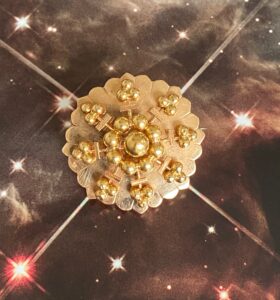
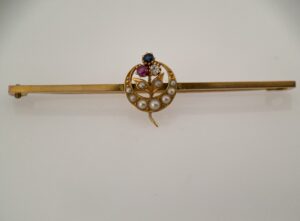
Gem Cutting Styles and Settings in Mid-Victorian or Grand Period Victorian Jewellery
Gems were largely cut as above in Early Victorian era, with following addition.
- cabochons, notably, in the Mid-Victorian or Grand Period, semi-precious gem cabochons, would often house a precious gem at the top. Usually a diamond or pearl (with a setting running all the way through).
Jewellery was often quite heavy and opulent during this time as the industry was booming due to gold and gemstone discoveries. What we now know as the star-set or gypsy-set rings were now popular, along with pave settings.
A lever catch was added to the ‘C’ settings in brooches to make them more secure as brooches became all the more popular.
Another notable trend was hairwork; which whilst had been used previously had gained popularity and greater level of technique during the Mid-Victorian era.

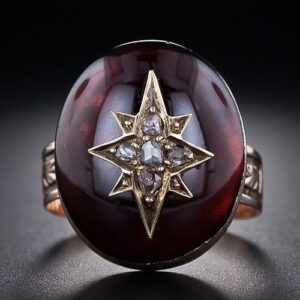
Popular Gemstones in Mid-Victorian or Grand Period Victorian Jewellery
Garnet, diamond, emerald, black onyx, jet, black glass, opals and pearls were popular during this period and cabochon cuts were de rigeur. Tortoiseshell and micro-mosaic elements in jewellery also became fashionable.
Metals Used in Mid-Victorian or Grand Period Victorian Jewellery
Silver, steel, and 9ct, 10ct, and 15ct gold was used extensively. Rose-coloured gold in all carats became incredibly popular too.
Late Victorian or Aesthetic Period (1885-1901)
This period saw a slight relaxation in mourning for Queen Victoria (and its fair to say the population at large was rather tired of the dark mood!). With that, rings and other jewellery items became increasingly delicate and light compared to the heavy Mid-Victorian pieces. It is in this period where we had art for art’s sake, with little placed on the significance, just the beauty of the piece was important. The discovery of opals in Australia at Lightning Ridge in the late 1890s catapulted this beautiful gem into prominence and it was often used in late Victorian jewellery and we at Anadej are delighted about this!
Motifs and symbolism in Late Victorian or Aesthetic Period Jewellery
Crescents and other celestial symbols were increasingly popular during this period, as were horseshoes, oak leaves, and trefoils. Double hearts with crowns or knots and bows and ribbons were popular.
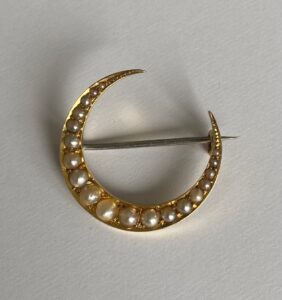
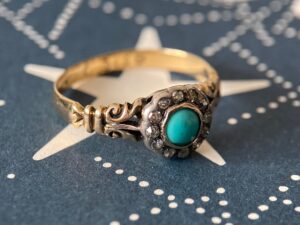
Gem Cutting Styles and Settings in Late Victorian or Aesthetic Period Jewellery
Gems were largely cut as above in Early and mid Victorian eras, with following addition.
- old European cut – like the old mine cut, but rounder and with a smaller culet.
Women’s jewellery became much smaller and lighter during this period to fit in with their busier lifestyles, as women were increasingly at work and fighting for the right to vote.
Tiffany and Co made the solitaire ring popular during this time and the navette or marquise-shaped rings gained popularity too. Bracelets were often stacked and were usually thick and thin bangles stacking together for a wonderful clink! Necklaces took on a fringed/draped appearance, but earrings were usually studs, with the exception of dangles for evenings later in the period.
Another notable trend was for Mizpah jewellery, especially rings. Mizpah is from Hebrew and means ‘Watchtower’, but is commonly interpreted as ‘May God watch over you’.
The Art Nouveau period was gaining ground in France, with incredible designers like Lalique on the rise, more on this will be discussed in our next article on Art Nouveau Jewellery.
Popular Gemstones in Late Victorian or Aesthetic Period Jewellery
Moonstones, opals, amethyst, aquamarine, peridot, emerald, sapphires, rubies and chrysoberyl were commonly featured during this time.
Metals Used in Late Victorian or Aesthetic Period Jewellery
Silver, gold of all carats, rolled gold and now platinum was popular.
Further resources for Victorian Jewellery can be found here:
- Language of Flowers
- Sentimental Jewellery – Antique Jewels of Love and Sorrow, Ann Louise Luthi
- Victorian Jewelry: Unexplored Treasures, Ginny Redington Dawes and Corinne Davidov
We hope you have enjoyed this article! We have a lovely range of Victorian jewellery with pieces from each of the eras noted and more are added on a regular basis as we find pieces we love and hope you will too. Please click here for our Victorian Rings, here for Victorian brooches or more widely Victorian Jewellery here.
Other Antique Jewellery Buyers Guides:
